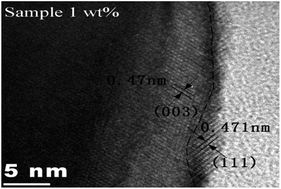Formation of different shell structures in lithium-rich layered oxides and their influence on electrochemical properties†
Abstract
A lithium-rich layered oxide with different shell structures was synthesized by a simple wet-chemical surface deposition method. X-ray diffraction (XRD), scanning electron microscopy (SEM), transmission electron microscopy (TEM), X-ray photoelectron spectroscopy (XPS), and other techniques were applied to characterize the crystal structure, morphology, and micro-structure of the samples. The surface of the lithium-rich layered oxide can successively produce island-like spinel, ultra-thin spinel, and thick two-phase (spinel and amorphous manganese oxides) separation shell layers with an increase in the coating amount. The formation process of the different shell structures and the effect of the shell structure on the lattice parameters were discussed. The different shell structures play an important role in the electrochemical performance of the lithium-rich oxide. In particular, when the coating amount is 1 wt%, the lithium-rich material with a uniform Li4Mn5O12 spinel shell layer exhibits superior electrochemical performance, and can maintain a discharge capacity of 209.9 mA h g−1 and 166.8 mA h g−1 at rates of 2C and 5C.



 Please wait while we load your content...
Please wait while we load your content...